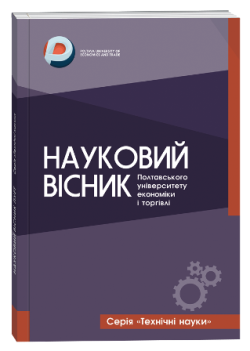TECHNOLOGICAL PROPERTIES OF SOFT WINTER WHEAT GRAIN DEPENDING ON THE VARIETY
Abstract
The purpose of the research is to assess the quality of the wheat grain in the conditions of the Right Bank Forest-Steppe of Ukraine. Technological properties of soft winter wheat grain of Ukrainian breeding varieties Darunok Podillia (control) and Aliot, as well as European varieties Skagen, Nordica, Avenue, which are respectively of German, Czech and French origin, were studied. It was established that the grain has standard indicators of freshness and quality. This allows it to be used not only for fodder purposes, but also in other areas of processing, including for the production of cereals and flour. Grain of Darunok Podillia variety belongs to the third class of wheat. The decrease in quality was influenced by the vitreousness of the grain (35.9%), as well as the bulk density (759 g/l), which corresponded to the norms of the second class of soft wheat grain. Grain of Aliot variety is defined as wheat of the third class according to the indicator of natural weight, (737 g/l) and vitreousness (only 32.7%). Instead, wheat of Nordica variety was identified as a third-class grain due to vitreousness – 39.2%. The leader in terms of natural weight (804 g/l) and vitreousness (58.4%) among the variants of the experiment, the French wheat variety Avenue is also determined as only the third class in terms of the number of falling number (209 s). And the best wheat sample in terms of a number of indicators is Skagen variety, which is distinguished by high values of falling number (284 s), vitreousness (42.4%), and by bulk density (731 g/l) is classified only into the third class. The decrease in grain quality of wheat of Skagen and Aliot varieties could be influenced by its content of impurities, where the predominant admixture is determined to be a lighter impurity fraction. In order to improve the quality of the German Skagen selection grain and the Ukrainian Aliot variety, we recommend it to be additionally cleaned from organic impurities. Grain of Darunok Podillia, Aliot, Avenue, Nordica and Skagen varieties can be used for flour production. Highly vitreous grain of the French wheat variety Avenue is recommended for cereal purposes.
References
Naukovi pratsi Instytutu bioenerhetychnykh kultur i tsukrovykh buriakiv – Scientific papers of Institute of Bioenergy Crops and Sugar Bee, 29, 144–151. doi: https://doi.org/10.47414/np.29.2021.244457 [in Ukrainian].
2. Zhemela, H.P., Shakalii, S.M. (2012). Vplyv poperednykiv na vrozhainist ta yakist zerna pshenytsi miakoi ozymoi [The influence of predecessors on the yield and grain quality of soft winter wheat]. Visnyk Poltavskoi derzhavnoi ahrarnoi akademii – Scientific Progress & Innovations, 3, 20–22 [in Ukrainian].
3. Liubych, V.V., Zheliezna, V. V., Kostetska, K. V. (2021). Porivnialna kharakterystyka tekhnolohichnykh vlastyvostei zerna 4-vydovoho trytykale [Comparative characteristics of technological properties of grain of 4 types of triticale]. Visnyk Umanskoho natsionalnoho universytetu sadivnytstva – Bulletin of Uman National University of Horticulture, 2, 63–68. doi: https://doi.org/10.31395/2310-0478-2021-2-63-51 [in Ukrainian].
4. Osokina, N.M., Kostetska, K.V. (2015). Tekhnolohichna otsinka zerna pshenytsi ta trytykale dlia krupianoho vyrobnytstva [Technological assessment of wheat and triticale grain for cereal production]. Visnyk Umanskoho natsionalnoho universytetu sadivnytstva – Bulletin of Uman National University of Horticulture, 2, 28–33 [in Ukrainian].
5. Osokina, N.M., Kostetska, K.V. (2016). Tekhnolohichna otsinka zerna sortiv yachmeniu, pshenytsi ta trytykale dlia krupianoho vyrobnytstva [Technological assessment of grain varieties of barley, wheat and triticale for cereal production]. Zbirnyk naukovykh prats Umanskoho natsionalnoho universytetu sadivnytstva – Collected Works of Uman National University of Horticulture, 88, 111–125 [in Ukrainian].
6. Sydorenko A.V., Snhyr V.P., Minenko O.V. (2011). Ekolohichnyi faktor i yakist zerna pshenytsi ozymoi [Environmental factor and grain quality of winter wheat]. Visnyk Poltavskoi derzhavnoi ahrarnoi akademii – Scientific Progress & Innovations, 2, 45–47 [in Ukrainian].
7. Khalukha, V.S., Ulych, L.I., Ulych, O. L. (2013). Vplyv ekolohichnoho chynnyka na realizatsiiu selektsiinoho potentsialu novykh sortiv pshenytsi ozymoi miakoi [The influence of the environmental factor on the realization of the breeding potential of new varieties of soft winter wheat]. Ahrobiolohiia – Agrobiology, 11 (104), 44-49 [in Ukrainian].
8. Riabovol, Ya., Riabovol, L. (2018). Otsinka yakosti zerna selektsiinykh zrazkiv pshenytsi miakoi ozymoi [Assessment of grain quality of breeding samples of soft winter wheat]. Visnyk Lvivskoho natsionalnoho ahrarnoho universytetu. Ser. Ahronomiia – Bulletin of Lviv National Agrarian University. Series Agronomy, 22(1), 194–200 [in Ukrainian].
9. Hlupak, Z. I., Radchenko, M. V. (2014). Analiz yakosti pshenytsi miakoi ozymoi v umovakh NNVK Sumskoho NAU [Analysis of the quality of soft winter wheat in the conditions of NNVK of Sumy National University]. Visnyk Sumskoho natsionalnoho ahrarnoho universytetu. – Bulletin of Sumy National Agrarian University, 2, 28–33 [in Ukrainian].
10. Seeds of agricultural crops. Varietal and sowing qualities. (1994). [Specifications]. (DSTU 224-93). Kyiv, Derzhpozhyvstandart Ukraine [in Ukrainian].
11. Seeds of agricultural crops. Methods of determining quality. (2003). [National standardizationbasic principles]. (DSTU 4138-2002). Kyiv, Derzhpozhyvstandart Ukraine [in Ukrainian].
12. Huang, J., Wang, Z., Fan, L., Ma, S. A. (2022). Review of Wheat Starch Analyses: Methods, Techniques, Structure and Function. Int J Biol Macromol., 203, 149. doi: https://doi.org/10.1016/j.ijbiomac.2022.01.149.
13. Poutanen, K.S., Kаrlund, A.O., Gоmez-Gallego, C., Johansson, D.P., Scheers, N.M., Marklinder, I.M., Eriksen A.K., Silventoinen P.C., Nordlund E., Sozer N.., Hanhineva K.J., Kolehmainen M., Landberg R. (2022). Grains – a major source of sustainable protein for health. Nutr Rev., 80, 1648–1663. doi: https://doi.org/10.1093/nutrit/nuab084.
14. Bao, J., Malunga, L.N. (2021). Compositional diversity in cereals in relation to their nutritional quality and health benefits. Front Nutr., 8. doi: https://doi.org/10.3389/fnut.2021.819923.


